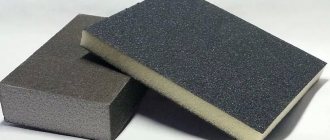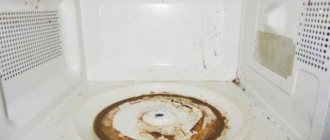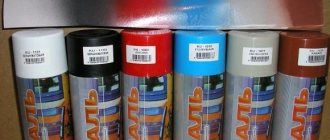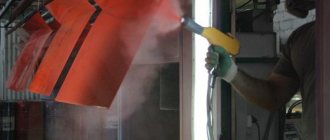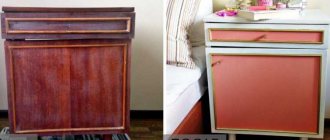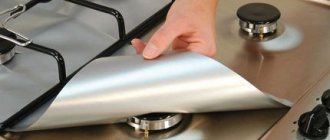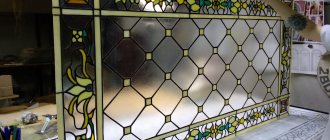Galvanized steel has become widespread and is in high demand in many areas and industries. The material, which is highly resistant to aggressive influences, is used in the manufacture of roofing, fences, pipes and many other products that come into direct contact with the environment and precipitation. Despite the fact that the zinc coating itself is quite a significant protection against damage, after some time of operation, galvanized products can be subject to corrosion and, therefore, begin to require additional protection. Coloring compounds are used as such protective measures, as well as to improve the aesthetic appearance of the product. It is this need that gives rise to a number of questions, namely: Is it possible to paint galvanized steel, how to paint galvanized steel, and how to paint galvanized steel without the paint peeling off.
The surface of galvanized products is distinguished by its smoothness and evenness. This aspect should be taken into account first of all when choosing how to paint galvanized steel so that it does not peel off after a short period of time after treatment.
SELECTION OF PAINT FOR PAINTING GALVANIZED
The most important step in painting galvanized steel is choosing the right paint. When choosing what and how to paint galvanized steel so that the paint does not peel off , you need to pay attention to the properties of the dye.
Paint properties required when painting galvanized products
- Elasticity;
- High level of adhesion to the surface;
- Resistance to ultraviolet rays;
- High level of hydrophobicity (resistance to precipitation);
- Good resistance to various temperature conditions and their changes;
- Accelerated drying process;
- Environmental friendliness and safety;
- Easy to apply. A single application should provide a layer of 60-300 micrometers;
- Fire safety;
- Good resistance to aggressive environments;
- High level of anti-corrosion properties;
- Good aesthetic qualities.
What is galvanized steel
Galvanized iron is steel sheets with a thin layer of zinc (otherwise called an anodic coating). Processing is carried out in industrial conditions. The technology uses such a feature of zinc as a lower electrode potential compared to the base alloy.
Galvanizing the metal provides mechanical and electrochemical protection, in which, even if the top layer is damaged, corrosion will not have a destructive effect on the steel alloy.
HOW TO PAINT GALVANIZED: TYPES OF PAINTS
Answering the question: “ how to paint galvanized steel so that the paint does not peel off ,” preference is given to the following paints:
- Acrylic emulsions. The basis of such paints is mainly an organic solvent. In addition to this paint option, there are also water-dispersion compositions. Acrylic paints have good anti-corrosion and moisture-repellent properties, show good adhesion to metal, have a long shelf life and a fairly low cost. In addition to the above, such paints are resistant to environmental influences. After application and drying, the paint gives an even matte finish to the surface. The approximate service life of such coloring is up to 15 years without loss of quality.
- Alkyd paints (enamels). Other names: polyester and epoxy polyester enamels. The paint gives the surface a glossy tint and has good performance in terms of resistance to aggressive influences and mechanical damage. In terms of their qualities, alkyd paints can adequately compete with the very popular powder dye, which is distinguished by its high quality of coloring. It is worth considering that the use of alkyd paints requires very careful preparation of the surface and does not allow the presence of foreign inclusions.
- Vinyl dyes. They are recognized as one of the most popular in this line despite their high cost. The popularity of this type of paint for painting galvanized steel is associated with its resistance to almost any aggressive influences and long service life. The quality indicators of vinyl paints significantly exceed those of other products in this area.
- Rubber coloring composition. The paint base is acrylic. The rubber composition is distinguished by its environmental safety, high resistance to aggressive influences and long service life. The composition applied in several layers creates a rubberized surface that, among other things, can absorb sounds well.
- Powder dyes. The composition of such dyes includes specialized additives, fine particles of polymer powder, hardeners, dyes and resins. During the heating process, the mixture polymerizes and creates a reliable coating with good adhesion. Powder dyes are a completely ready-to-use composition that does not require the use of solvents. It is worth considering that after the application process, the surface to be treated must be subjected to uniform heating for polymerization. In this regard, the use of powder dyes at home is almost impossible.
List of some types of coloring compositions for non-standard conditions
Cyclol. It is an acrylic dye.
Stainless steel enamel. Enamel paint with long service life and good quality.
Serebrol. Aluminum enamel has a pronounced anti-corrosion property. Does not require surface priming.
Polistil. Enamel related to fire-resistant paints.
Quick Thrower Suitable for coloring products heated to 100 degrees.
Zinga. Enamel that has the ability to conduct electrical current.
The use of oil paints for processing galvanized steel is not recommended due to the presence of components that have a destructive effect on such a surface. An important process before painting is definitely welding. If you are interested in learning more about defects in welds and connections and how to eliminate them, you can read here:.
Deciding on the dye
How to paint galvanized steel must be decided at the beginning of the work or even at the planning stage, since not every coloring composition may be suitable for the surface. Standard painting of galvanized elements is quite primitive, and therefore, in order for galvanized products to be combined with the overall interior of the building, they are additionally painted in the desired color.
The main purpose of zinc coating is to decorate and protect steel surfaces, elements and structures from negative external factors.
Nuances when working with galvanized surfaces
When planning to work with elements made of galvanized steel, the following points should be considered:
- You should choose a material that contains not only special additives to increase grip on the steel surface, but also anti-corrosion elements
- Galvanized products cannot be treated with paint and varnish compositions that contain chemicals that contribute to the destruction of zinc, for example, various anti-corrosion additives, acids, solvents and alkalis;
- For structures operated in harsh aggressive environments, it is necessary to use specialized compositions - electrically conductive and fire-resistant paints for metal products;
- Galvanized coatings have a smoother surface compared to untreated surfaces of the material, and therefore adhesion to other materials will be lower. Based on this, before painting galvanized steel, you should carefully prepare the working surface, increasing the adhesion of zinc to the new paint and varnish composition;
- It is also important to pay attention to the degree of elasticity of the material, since a coating with poor elasticity will simply crack and delaminate on a metal surface, which is characterized by slight changes in shape when heated and cooled. All this will lead to the fact that the composition will simply completely “peel off” from the steel surface over time.
We recommend: How to install sliding gates - 10 mistakes
Important point! Paint for zinc should not negatively affect the characteristics of steel; it must have good adhesion, high elasticity and resistance to external negative factors.
Choosing a Zinc Coating
Steel surfaces can be treated with various colorants:
- Polymer paints, which can vary greatly in their characteristics. Today, ground enamels, as well as latex and polymer compositions, are distinguished. In practice, despite the high cost, ground enamels have proven themselves to be excellent;
- Alkyd compounds that perfectly protect metal surfaces. In addition, they stand out for their considerable service life and a wide range of colors;
- However, alkyd paints are not recommended for use as a protective agent for galvanized products due to the fact that the paint contains aggressive components that can affect the surfaces of steel elements!
- Oil paints. The characteristics of the coloring composition allow it to create a film on the treated coating that does not allow water to pass through. Thanks to this, the galvanized product becomes well protected from the effects of snow and rain. At the same time, such paints have good adhesion to steel. However, oil-based paints also contain substances that can react with zinc, causing its destruction. Based on this, it is not recommended to use such products for painting galvanized steel.
- When choosing a paint composition to protect steel elements, it is better to give preference to acrylic primer enamels containing neutral substances that cannot have any negative effect on steel!
The cost of paint can vary greatly. By and large, the price will depend on the manufacturer and the volume of the can. When purchasing, you should choose products from a trusted manufacturer. If you plan to do the painting work yourself, the final cost will be lower!
PREPARING THE SURFACE FOR PAINTING
In the question “ how to paint galvanized steel so that the paint does not peel off ,” you should follow certain recommendations for preparing the surface of galvanized steel:
Removing old paint using the stripping method
For these purposes, sandpaper or sandblasting is used. Cleaning is done so that the old coating is removed, but the base is not damaged.
Treatment with a degreasing compound
Degreasers allow you to remove dirt, grease, mold and other deposits from the surface that can impair the quality of the paint. At the same time, the degreasing composition does not damage the surface of the product itself. It is recommended to carry out treatment in small areas to prevent problem areas from being missed.
For cleaning and degreasing, the following are most often used:
- White Spirit;
- Chlorine bleaches;
- Comet;
- Kerosene.
Drying
It is carried out until the surface is completely dry to prevent the degreaser from reacting with further applied products.
Removing white rust
White rust occurs as a result of the destruction of the galvanized layer under the influence of the environment and is a white powdery film. White rust can be removed using fine-grit sandpaper with a grit rating of 120 or less. Sanding is done with light circular movements. At the end of the process, the dust is removed with a slightly damp cloth or rags.
Abrasive treatment
To improve the adhesive properties, allowing the paint to adhere as firmly as possible to the surface being painted, the steel must be treated with abrasives and white (distilled) vinegar. The acid contained in vinegar will etch the galvanizing and give it a rougher structure; substances containing abrasive particles will help enhance the effect.
Exposure to vinegar is usually a minimum of 1-2 hours. It is worth considering that the longer the acid acts on the surface, the more pronounced the etching effect.
Padding
Most often, latex and epoxy primers for exterior use are used for these purposes. It is worth considering that due to its durability and resistance to damage, epoxy primer is optimal in cases where the product will be in the most aggressive conditions. The composition is applied with a brush or spray. The latter is most appropriate if we are talking about a large cultivated area. Application is carried out in a sectional manner, allowing for the most accurate distribution of the primer. Exposure time depends on the brand of primer mixture used and averages from 2 to 6 hours. You can start painting only after the primer has completely dried and there is no sticky effect.
Is it necessary to paint galvanized metal?
Although the zinc layer provides a high degree of protection, the coating thickness is 0.8-2 microns. Gradually it will begin to deteriorate, and white rust will appear on the metal. A metal surface deprived of protection is exposed to aggressive environmental influences. Painting galvanized steel helps protect the base from corrosion and prevent the destruction of products.
Galvanized metal is most often used for structures such as roofing, or for exterior work where strength and integrity are especially important.
HOW TO PAINT GALVANIZED: PAINTING METHODS
Let's consider the following ways to paint galvanized steel so that the paint does not peel off :
- Pneumatic. It is carried out using a spraying device powered by compressed air. This method is available in any conditions that involve processing a sufficiently large surface. It is worth considering that working with a pneumatic sprayer requires selecting the paint supply speed, the shape of the spray torch and the ratio of air speed and paint composition flow. Spraying paint in this way is considered neither economical nor environmentally friendly. However, if all the rules are followed, it gives a high-quality result.
- Airless. A more economical method involving direct application of paint to the surface. This technique is only suitable for painting smooth surfaces.
- Combined. It is produced by applying the composition under high pressure and is suitable for painting complex surfaces.
- With a brush. Suitable for painting small surfaces. It is better to choose a brush with a wide base.
- Aerosol can. This type of painting is useful when treating small surfaces, recesses and eliminating cracks.
HOW AND WHAT TO PAINT GALVANIZED: CONCLUSION
Outdoor work on painting galvanized steel is carried out at temperatures from -10 to +45 degrees. It is recommended to carry out staining in three stages. Each subsequent layer is applied only after the previous one has completely dried. Compliance with all the listed rules and aspects will allow you to create a stable, high-quality and aesthetically attractive coating. Regardless of the chosen painting method and type of paint, all work must be carried out in compliance with all safety measures.
